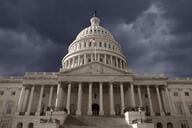You have /5 articles left.
Sign up for a free account or log in.
The 2007 College Cost Reduction and Access Act (CCRAA) spawned two huge problems in federal financial aid: It caused fights over arbitrary interest rates and it established an ill-designed student loan repayment program.
On interest rates, the 2007 law gradually lowered rates on some student loans from 6.8% to 3.4% and then scheduled an increase back to 6.8%. Of course, once rates reached 3.4%, it was more than a little difficult to explain that this was an arbitrary number chosen in 2007, and therefore should exert no influence in determining rates going forward. Fortunately, Washington has finally come to its senses, and will avoid this problem in the future by tying interest rates on student loans to the government’s own cost of borrowing, thus fixing the first problem spawned by the CCRAA of 2007.
While we wait for the ink to dry on the interest rate compromise, policymakers should turn their attention to the even bigger problem with the CCRAA of 2007 – the income-based repayment (IBR) program. IBR, in typical Washington fashion, took a great idea — income-contingent lending (ICL) -- and “fixed” it until all that was good about it was no more.
What Income-Contingent Lending Can Offer
Under income-contingent lending, the amount borrowers pay each month is tied to their incomes, so borrowers repay less in months when their incomes fall (such as during an unemployment spell), and repay more quickly when their incomes rise. Arguments in favor of ICL are so strong that advocates have included the late Nobel laureates Milton Friedman on the right and James Tobin on the left.
ICL’s greatest strength is that it eliminates the possibility of default. Borrowers are never put in situations where they can’t afford to make their payments, since payments automatically decline when income declines. This is a huge stress reducer for students, and it can also be beneficial for lenders, since it reduces the possibility that they will get nothing back.
income-contingent lending also improves access and equality of opportunity. Current loan programs do not increase access as much as they should, because many borrowers fear being trapped in permanent financial purgatory by their student loan debts. By simplifying lending and eliminating the fear of default, ICL would be more attractive for those segments of the population that currently avoid student loans (and therefore college).
Another set of advantages stem from getting the government out of the student loan lending business. While an ICL with the government as the lender would be administratively cost-efficient (since loan repayments could be incorporated into the existing tax-withholding system), the benefits of moving to private lending are even greater.
It is true that past private student lending in this country certainly hasn’t inspired confidence, with subsidy-fueled corruption and high interest rates being the two most accurate descriptors. But these characteristics were driven not by anything inherent in private lending, but by poorly designed features of those lending programs. Past corruption was due to the fact that the federal government set interest rates and offered subsidies to lenders. And high current interest rates on private loans are due to the lack of collateral and the fact that individuals typically resort to private loans after maxing out their federal loan (meaning they already have a lot of debt, which makes lending to them risky). A properly designed ICL overcomes all of these problems, since there are no subsidies, the government doesn’t set interest rates, and the student’s future earnings function as collateral for their student loans.
The main advantage of private lending is that interest rates would no longer be one-size-fits-all. Currently, a stellar student in a field with many job opportunities (e.g., nursing) pays the same interest rate as a bottom-of-the-class student in a field with dismal job prospects (e.g., law) despite differences in the riskiness of lending to these two students.
With private lending that would no longer be the case, and the stellar nursing student would be able to obtain a lower interest rate than a slacker law student. Private lending would therefore provide students with more guidance on their choice of majors and provide incentives for students to do well in school. In addition, with private lending, the political pandering we just witnessed in setting interest rates would be eliminated, and public funding would be freed up for other uses (such as expanding Pell grants).
Potential Drawbacks of Poorly Designed ICLs
Some drawbacks can be exacerbated if an ICL is not properly designed. First is “adverse selection.” This is particularly problematic when borrowers are jointly responsible for their class (or cohort’s) total amount borrowed, as was the case in a Yale University experiment in the 1970s (more on that a bit later). With cohort-based accounts, those students expecting to have high incomes will avoid loans, while those students expecting low incomes will eagerly borrow, confident that others will repay their loans for them. This problem can be avoided by establishing individual, rather than cohort, accounts. While the amount due monthly for each student would still be contingent on income, the total amount repaid (except for interest) would not be. High earners simply would pay off their personal debt faster.
The second potential drawback is “moral hazard,” which could apply to students or colleges. Some students might try to deliberately lower their incomes to lower their monthly payments. While there isn’t much danger of students choosing to remain unemployed to avoid repaying their debts, there is the danger that some might seek out jobs with greater nonmonetary compensation such as travel or vacation time. This danger could be handled by designing individual accounts and eliminating loan forgiveness in all but the most extreme cases.
Moral hazard could also apply to colleges, if they see the students’ reduced fear of borrowing as a license to raise tuitions. Law schools are the poster children for this phenomenon, with loose lending standards for federal GradPLUS loans leading to skyrocketing law school tuitions and debt. This danger could be mitigated by including reasonable eligibility criteria and imposing strict annual and aggregate loan limits in the program’s design.
If ICL is so great, why has it failed (in America) so far?
While ICL has many advantages, and has worked in Australia, the United Kingdom, and New Zealand, two attempts in to implement an ICL program in United States have not worked. Fortunately, these experiments have taught us mistakes to avoid.
The first attempt at an ICL in America began at Yale in 1971. It suffered from two serious problems: it was limited to one college and it used a class account, rather than individual accounts. Running an ICL program on a single campus is difficult because colleges have difficulty verifying the income of graduates and collecting payments. The Yale program also used a cohort account in which every student had to keep paying until the entire class’s debt was repaid. High-earning graduates did not like the fact that they paid much more than they borrowed, while some of their classmates paid less. The Yale program stopped accepting new borrowers in 1978.
The second attempt to establish an ICL came in 2007 with the IBR program, which is still in effect. IBR originally limited payments to 15 percent of disposable income (defined as the income above 150 percent of the poverty line), with any remaining balance forgiven after 25 years of repayment (10 years if graduates worked in politically favored professions). The Health Care and Education Reconciliation Act of 2010 cut this to 10 percent of disposable income and 20 years until forgiveness.
Any one of these provisions could work by reducing the generosity of other provisions, but the combination of a large income exemption, low repayment percentage on remaining income, and easy and automatic loan forgiveness have transformed IBR from a ICL-based loan program into a delayed grant program.
This is made clear by the handy calculator Jason Delisle and Alex Holt at the New America Foundation created to accompany their excellent report "Safety Net or Windfall?" The average undergraduate college graduate who borrowed has $26,600 in debt. If a graduate’s salary grows by 4 percent a year, payments for any student with a starting salary under $30,300 (of which there are many) would not even cover the interest on his or her loans. After 20 years, the entire loan principal would be forgiven at taxpayer expense. In other words, many typical students will not repay their student loans under IBR. Instead, they will receive loan forgiveness worth tens of thousands of dollars. And if those borrowers have children, their loan payments go down even more. For example, if a borrower has a child five years after college, the borrower could have a starting salary of $35,000 and not repay a cent of principal over the life of the loan. In the understated words of Rep. Thomas Petri (R-WI), Income Based Repayment (IBR) “fails to live up to its potential.”
The bottom line is that IBR is no longer a loan program. It is a grant program, a delayed grant program. Politicians of both parties could not resist the temptation to promise current students and constituents huge giveaways years from now while leaving the job of figuring out how to pay for it to the policymakers who will inherit these unfunded promises in the future. To avoid this problem, the temptation to make repayment provisions more generous needs to be balanced by the requirement that promises are paid for at the time the promises are made. If politicians want to make the student loan program more generous, they should be the ones that have to sacrifice other priorities to do so, rather than leaving their promises unfunded and sticking future politicians and taxpayers with the bill.
One blatant example of the absence of balance is the continual debate over the length of time students make payments before their loans are forgiven. This debate is completely misguided – loan forgiveness is a solution to a problem (unaffordable payments) that would not exist under a well-designed income-contingent lending program, since ICL already ensures that payments are always affordable. The main reason for loan forgiveness in an ICL is to enable politicians to pander by making unfunded promises.
What Should be Done?
America’s past experiments with ICL programs have taught us valuable lessons about how NOT to design an ICL program. We learned that a single college cannot run an ICL program. We learned that individual accounts are better than communal accounts. We learned that the program should not include any loan forgiveness. And we learned that to avoid ever-increasing unfunded promises, the program needs to be set up so that more generous promises are paid for when they are made — by those who made them.
The advantages of income-contingent lending are so great that we should not delay in implementing this new and better student lending system, making sure to incorporate all the lessons we’ve learned the hard way.




